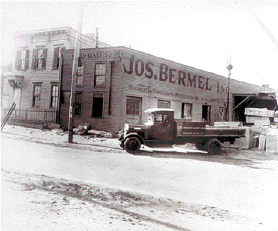Joseph Bermel was born on April 8, 1860 and was a native of Brooklyn. He went to the public schools of Brooklyn until he was 16 then he apprenticed himself to a stone cutter with whom he served four years. He was a journeyman cutter for two years and then in 1883 he went into business for himself.
Bermel married Mary Timmes on October 21, 1884 and they had five children: Eva, Joseph, Jr, Mary, John and Elizabeth. The Timmes family lived in Middle Village during the 1800's. They were in ironwork and many an iron bench in the local cemeteries bear the Timmes name. The Timmes home was located on Metropolitan Avenue and
69th Street.
After Bermel married Mary Timmes the Timmes family allowed Joseph to display head stones on their front lawn which was the start of the Bermel business. At one time Bermel had thirty stone cutters working for him.
Joseph Bermel was an active member of St. Margaret's R.C. Church. When the church celebrated its Golden Jubilee in 1910 Joseph Bermel was President of the Golden Jubilee Committee. He was also an active member of the Fearless Hook and Ladder Co. in Middle Village.
He lived on the corner of 78th Street and Metropolitan Avenue. His home later became the home of the Montauk Democratic Club. The building was eventually demolished and replaced with a row of stores. Mace's now occupies the largest of the stores.
Joseph Bermel held various political offices, He was Public Works Commissioner in 1905 and on January 1,1906 he was elected the third Borough President of Queens. He claimed to be all for reform and tried to trim the payrolls. However, in 1908 Governor Charles Evans Hughes, a Republican, started an investigation of Bermel.
In 1907 Bermel pushed the city to buy 87 acres of swampy land in Flushing for $347,000. Bermel was particularly careful not to tell anybody that he owned the land, most of which was unfit to give the citizens anything but wet feet. There were complaints, a grand jury was called and it was estimated that the city had overpaid by $260,000. A grand jury summoned Bermel. Today that swampy land is Kissena Park.
After some testimony Bermel said he was sick. He left the courthouse with two assistants holding him up. The grand jury was scheduled for 2PM the next day. Bermel resigned his office and fled to Europe. At 2:30PM he sailed on the liner Savonia at pier 46, North River, Manhattan. The ship took him to Naples, and he left there only when the grand jury died.
The Bermel business turned out many famous stones and monuments. Perhaps the most famous one was the Slocum Disaster Monument in All Faiths Cemetery. Services are held every year in front of the monument since 1904, when the disaster occurred. Joseph Bermel built the Slocum Monument. It has four symbolic figures of Despair, Grief, Courage and Belief in the hereafter, which is the marble figure with finger pointing towards heaven.
The triangle at Cooper and Myrtle Avenues and 70th Street was the site of the first war memorial in Glendale. A crude wooden cross was placed there on Memorial Day, May 30, 1919 when services were held for the men from Glendale who died in World War I. One hundred twenty five thousand Americans lost their lives in the war. Joseph Bermel from Middle Village constructed the granite monument. It was dedicated with a bronze plaque on Memorial Day, May 29, 1921.
Joseph Bermel died while on vacation in Europe in 1921. After a mass in St. Margaret's Church he was buried in St.John's Cemetery.
The Bermel business on Dry Harbor Road and Metropolitan Avenue burned down in December 1973 and all records were lost. The fire was started by a molotov cocktail thrown into McCloskey Florist and the fire quickly spread to Bermel and the adjoining pub. They think a disgruntled patron of the pub might have aimed the firebomb, missed his target and it hit McCloskey, next door to the tavern, instead.
In 1977 Mrs. Seiss, an adopted daughter of Eva Bermel Althoff, had a small office on the corner of 69th Street and Metropolitan Avenue. She ran the business of Bermel from that office. Mrs.Seiss was kind enough to lend me the picture of the Timmes house. Mrs.Seiss had always believed that the picture was a lithograph. In truth it was an original pen and ink drawing rendered in the early 1880's.



